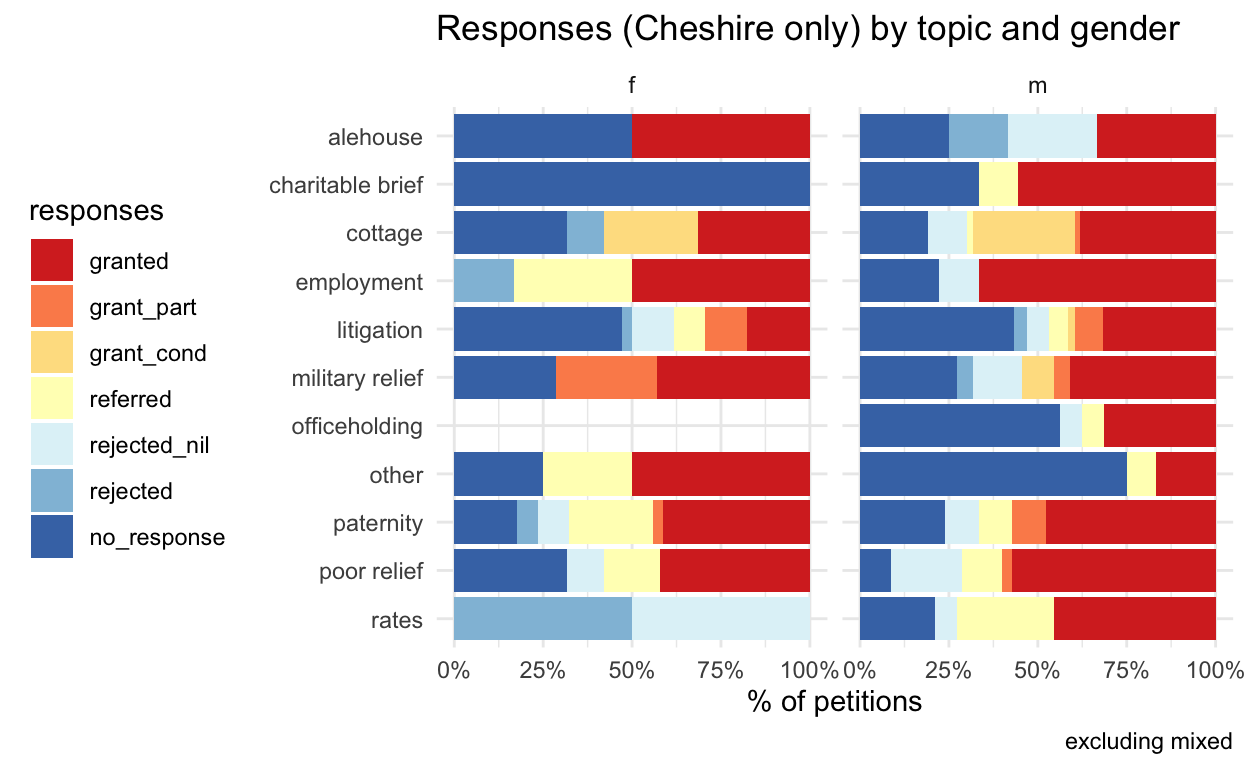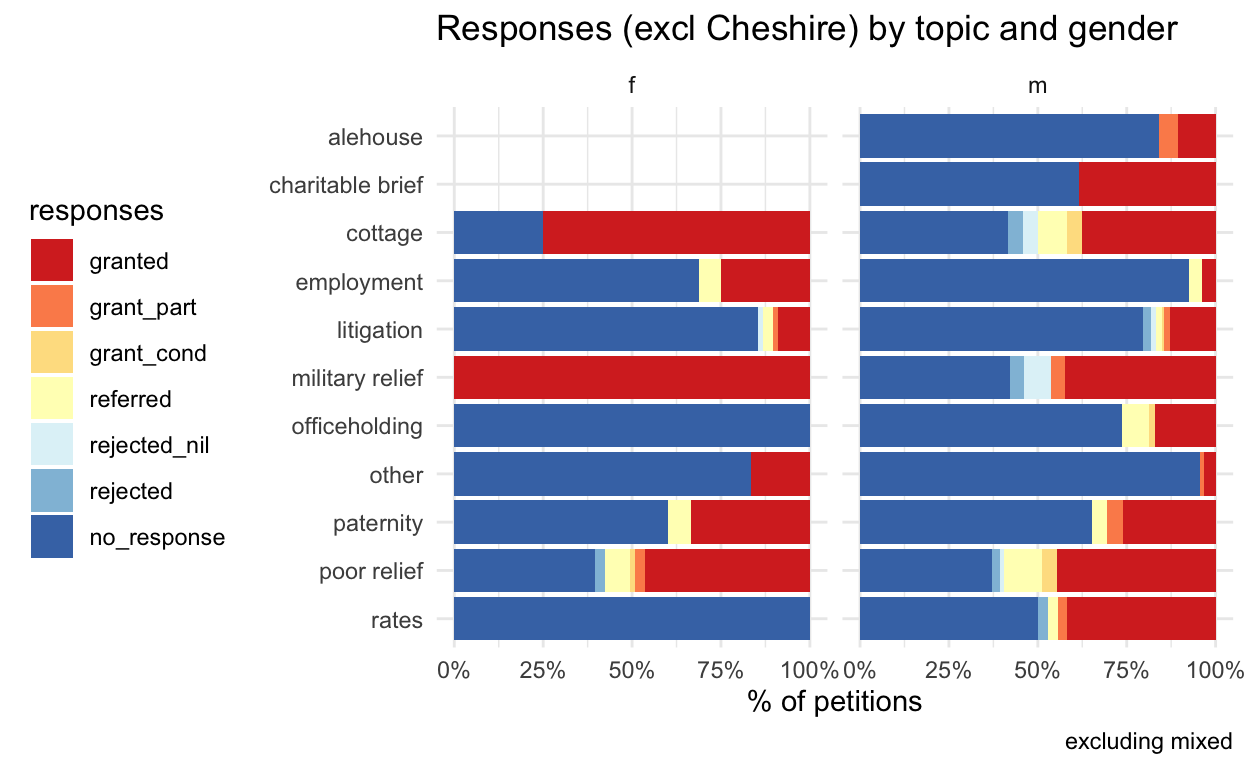Cheshire Quarter Sessions petitions
[Updated]
I initially focused on Cheshire quarter sessions; although this is still my main interest, I’m now able to add some data for the four other counties in TPOP’s transcribed QS collections (Derbyshire, Staffordshire, Westminster and Worcestershire) for comparisons.
The data
The data is available, with full documentation, from Zenodo.
Cheshire: I’m working with a sample of 613 petitions from the Cheshire QS files between 1573 and 1798. I photographed all surviving petitions from every year ending in -8 between 1608 and 1798, plus every pre-1600 calendared petition. (My estimate is that there are in total about 5000 petitions in the files.) TPOP transcribed all the 16th-century petitions and a 1-in-20-year sample for the 17th and 18th centuries (years -08, -18, -38, -58, -78, -98); I abstracted the rest, and encoded all the responses.
For the other four counties, I have a total of 1115 petitions (1589-1799). As I’ve noted elsewhere, the survival of petitions in these collections is much more patchy than for Cheshire. Also, the individual counties’ numbers are smaller (Derbyshire in particular has only 94 petitions).
I’m using only responses written directly on the petitions. This may miss responses recorded in separate documents, though I haven’t found any extra information while consulting the Cheshire files. I’ve also examined the 17th-century Cheshire QS order books, but haven’t found additional responses there; they’re more useful for fleshing out the reasoning behind the brief summaries on the petitions.
About 70% of the Cheshire petitions have some kind of annotated response and, since I couldn’t find further records of responses, I decided to treat the absence of a recorded response as a type of negative response. However, annotated response rates have turned out to be considerably lower (and quite variable) for the other counties, and I haven’t been able to check for additional sources for those collections. So this will need to be borne in mind when making comparisons.
The detailed coding categories:
- granted = request granted in full
- grant_part = request partially granted (eg smaller amount of relief than requested)
- grant_cond = granted, but conditional on the petitioner doing something
- referred = to be further investigated or mediated outside the court, usually by local JPs
- rejected_nil = rejection with only the terse annotation “nil/nihil” or “nothing”
- rejected = rejection with a reason given (including “absent”)
- no_response = no response written on the petition
- uncertain = an apparent response, but it couldn’t be interpreted (eg damaged or illegible).
Simplified positive/negative:
- positive = granted, grant_part, grant_cond or referred
- negative = rejected_nil, rejected, no_response
I’ll exclude the small uncertain group from analysis (some may not even be responses), so I’m looking at 593 Cheshire petitions and 1083 others.
Overview
How often do petitioners get what they want?
Overall, 56.3% of the 593 Cheshire petitions received a positive response, which suggests is that petitioners to the Cheshire magistrates had a reasonable chance of getting at least part of what they wanted, but a positive outcome was far from guaranteed.
However, petitioners in the other four counties appear to have been less likely to get a positive response, averaging only 28%. Westminster stands out with an exceptionally low positive response rate of only 7.9%.
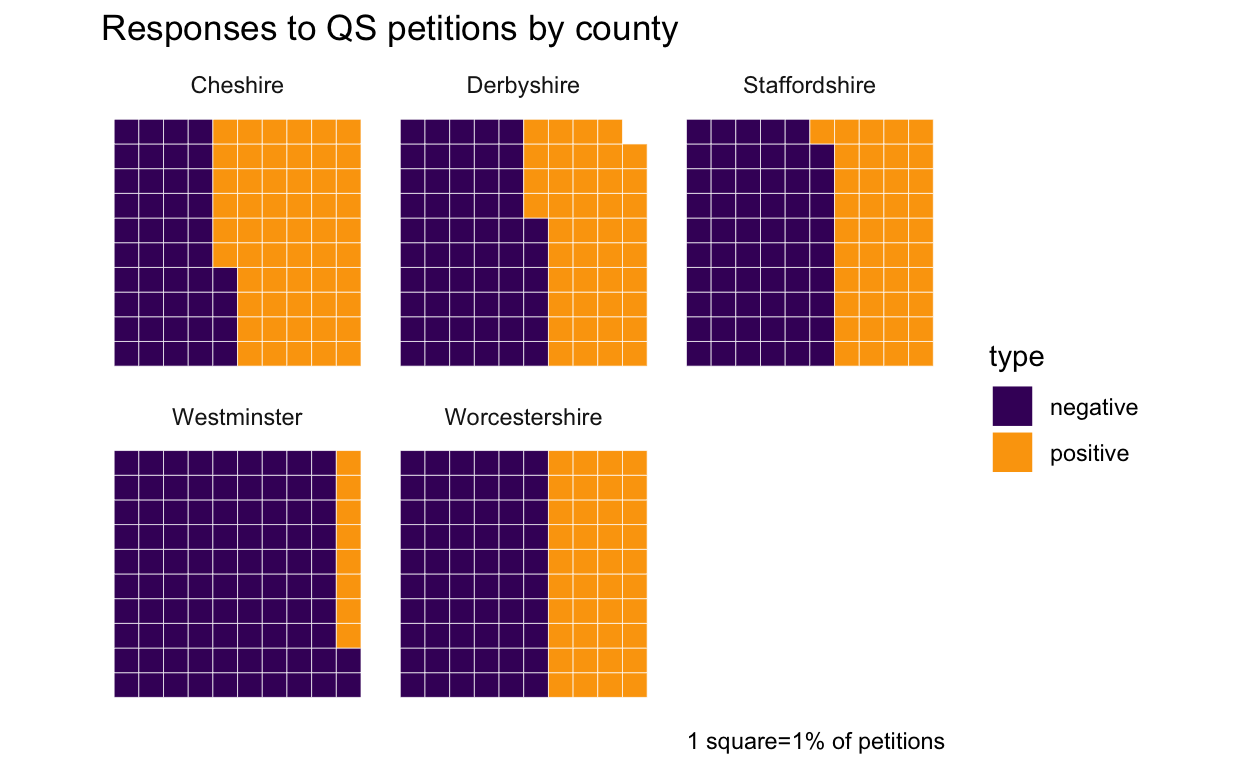
A more detailed breakdown:
Cheshire: 229 (37.3%) requests were granted in full, 50 (8.4%) partially or conditionally and 55 (9.3%) were referred. 75 (12.6%) were rejected with a response and 184 (31%) had no response.
The other counties vary, but it’s clear that the main difference is no-response petitions. Westminster is so different from the other counties that it does suggest the possibility of very different recording practices.
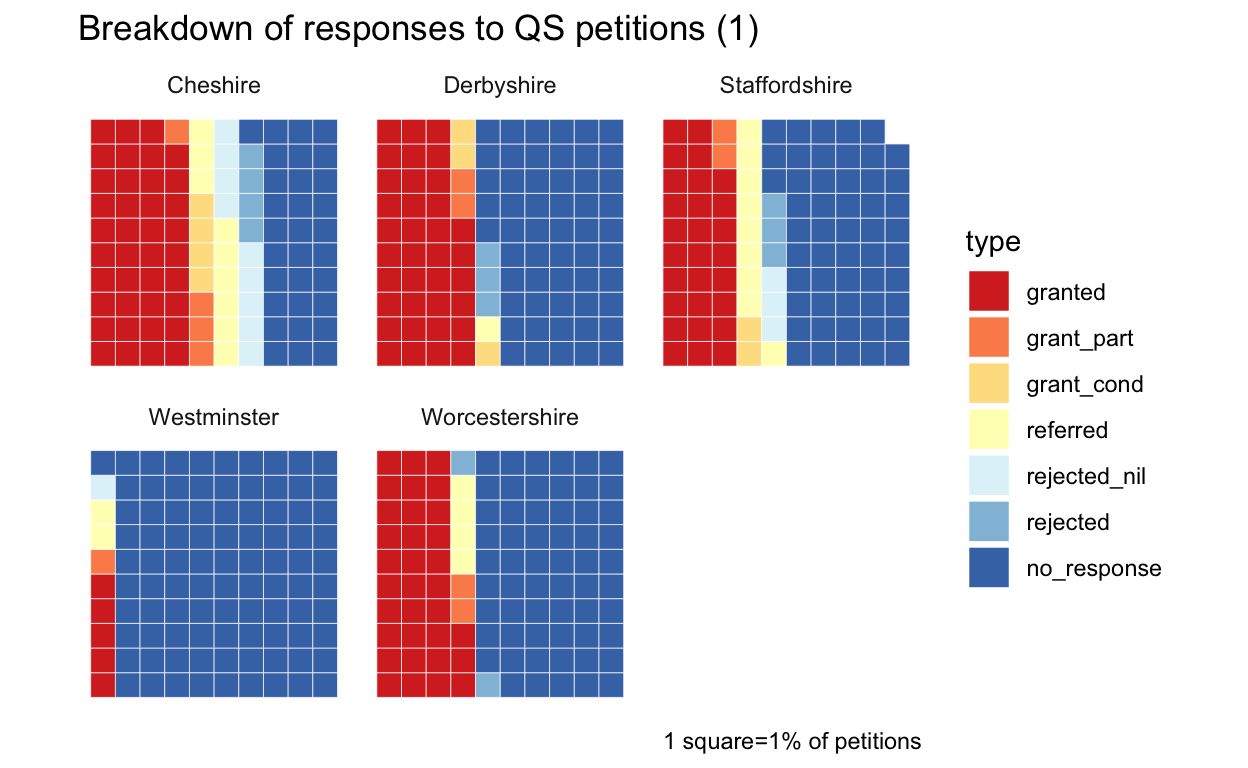
On the other hand, there are some broad similarities between Cheshire, Derbyshire, Staffordshire and Worcestershire. If negative response and no response petitions are combined, the differences between these four counties are less noticeable. Cheshire JPs were more likely to respond positively to petitions, but it seems they were also simply more likely to bother to annotate a negative response. Derbyshire magistrates were least likely, apparently, to refer petitions for further arbitration.
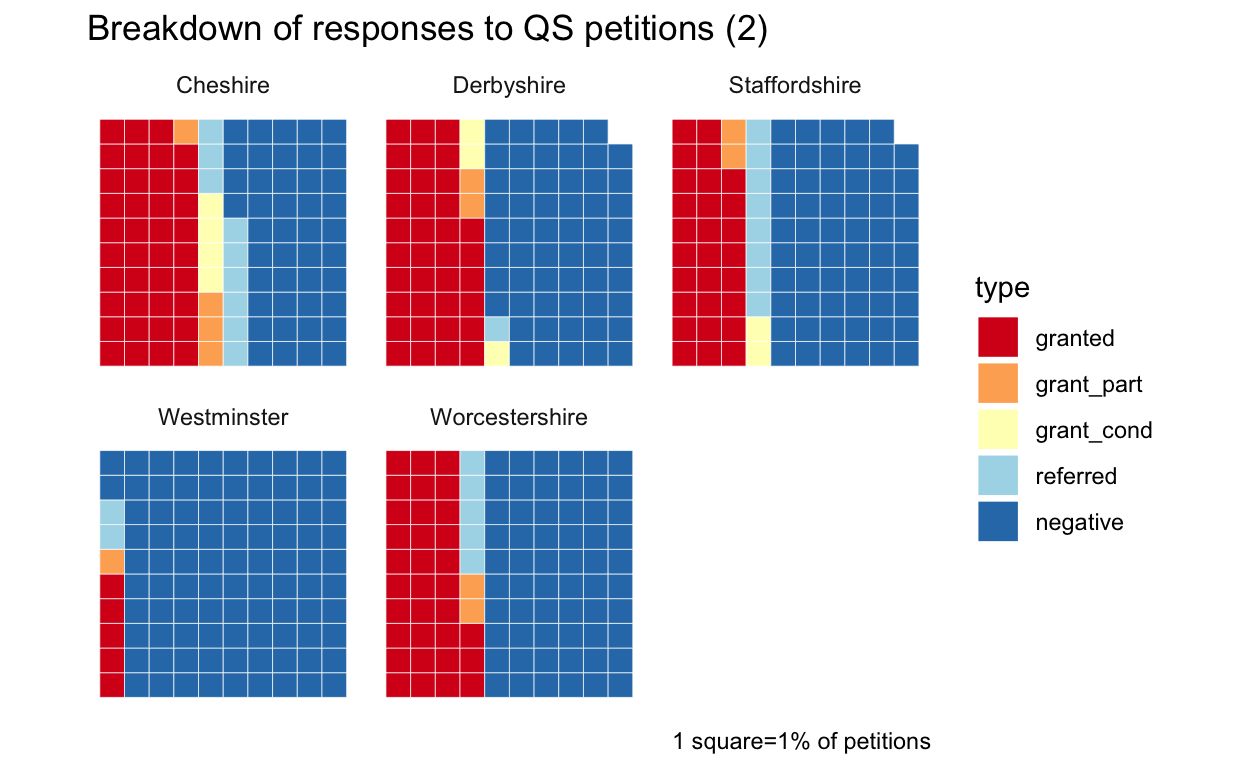
In more depth
Could variations in responses point to factors that increase or reduce the chances of success?
petition topics
The topics are a set of broad categories manually assigned by the project for QS petitions; a couple of topics with very low numbers (dissenting worship, debtors - <10 petitions) have been merged into the “other” category.
The proportional bar chart on the left shows the detailed breakdown of responses (Cheshire QS only). The smaller chart on the right shows the % of positive responses and the size of the square indicates the relative size of the category.
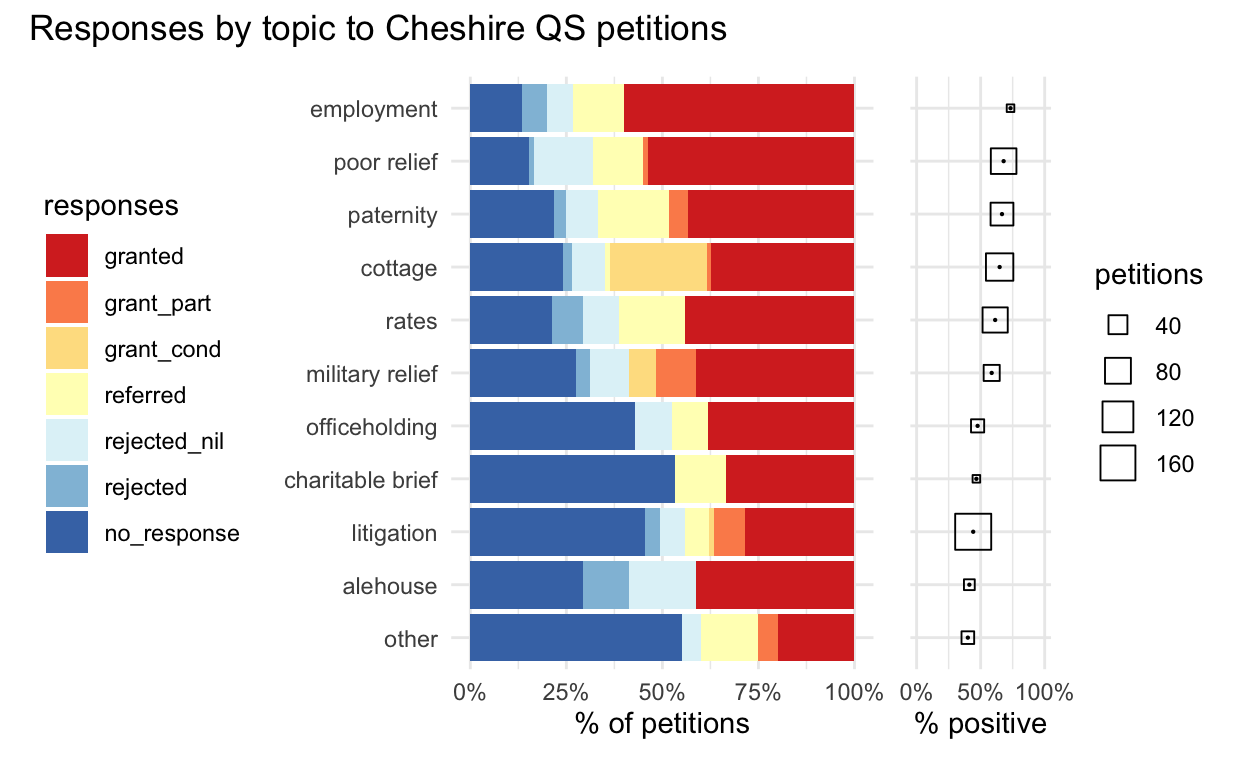
In some categories, the numbers may be too small to draw any real conclusions. Even so, it’s noticeable that there is some relationship between the number of petitions in a topic and the likelihood of a positive response; that’s to say, smaller topic categories are less likely to get a positive response. The exceptions to this pattern are the largest category (litigation, 171 petitions and one of the lowest positive response rates at 44.4%) and employment (15 petitions, 73% positive responses).
But when analysis is extended to the other counties, the patterns are rather different and that possible correlation disappears.
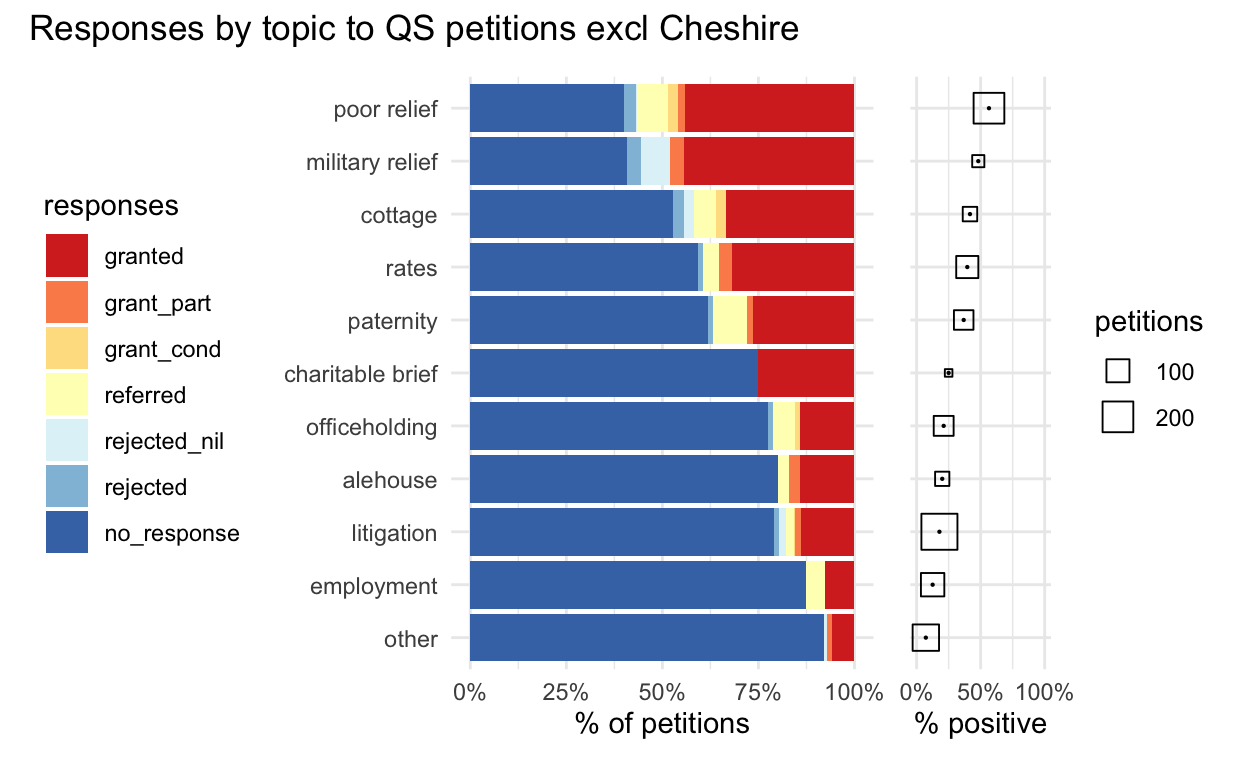
Additionally, Cheshire has two very distinct clusters in positive response rates by topic size.
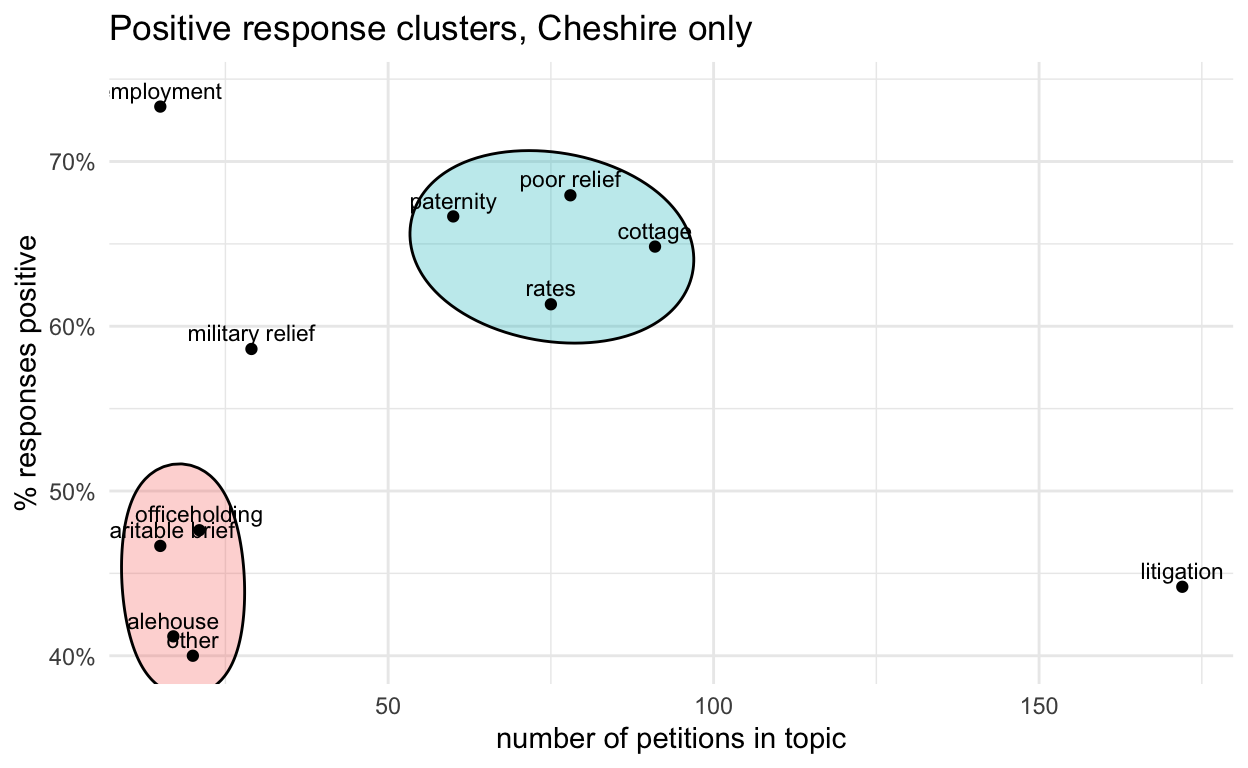
For the other counties there is no sign of the same clustering by topic size. But in terms of positive response %s there are some similarities in topics.
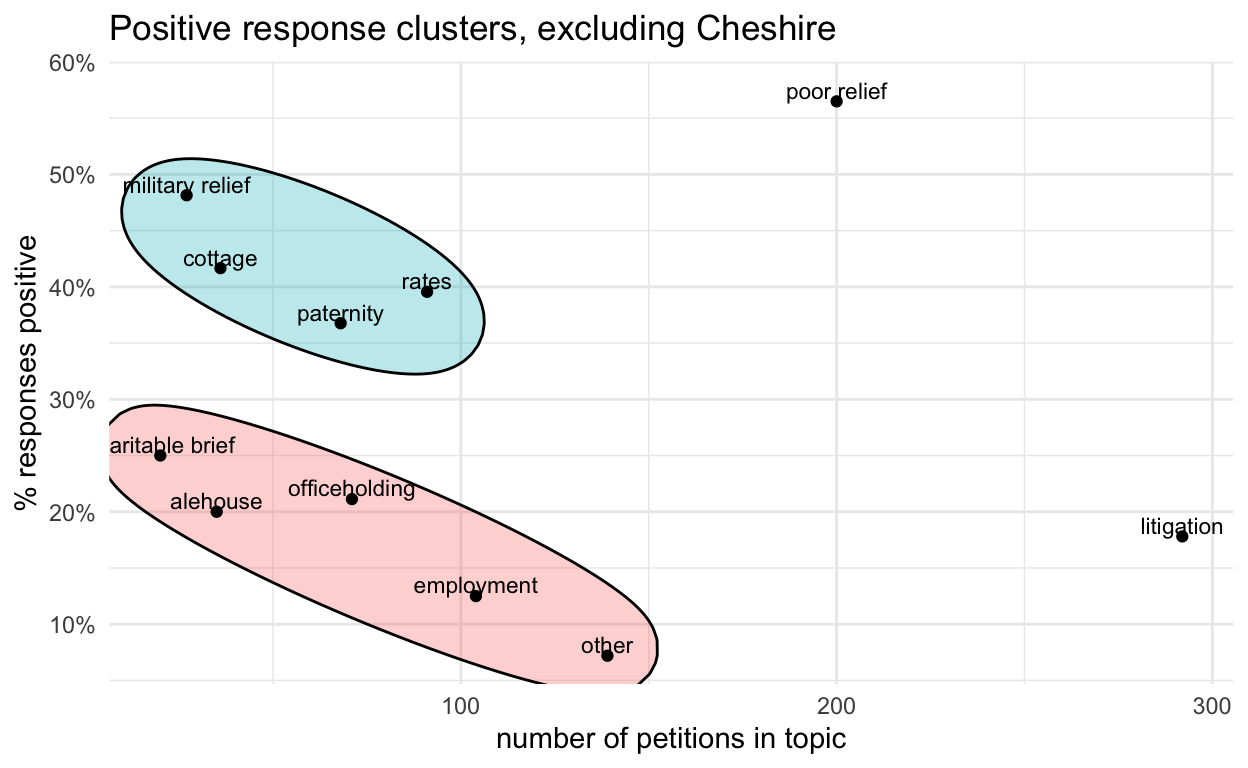
Another feature to note is the unusually high percentage of conditional responses for cottage petitions; it was very common for a request to be allowed to build a cottage to be granted on condition of obtaining the consent of the lord of the manor.
petition type
Variations here appear to be much less noteworthy than previous categories of analysis.
Three types
- single petitioner (413)
- multiple named petitioners (72)
- collective (eg “inhabitants of Nantwich”) (108)
There is very little difference in overall positive/negative responses to the three types, though single-petitioner petitions are slightly more likely to receive a positive response.
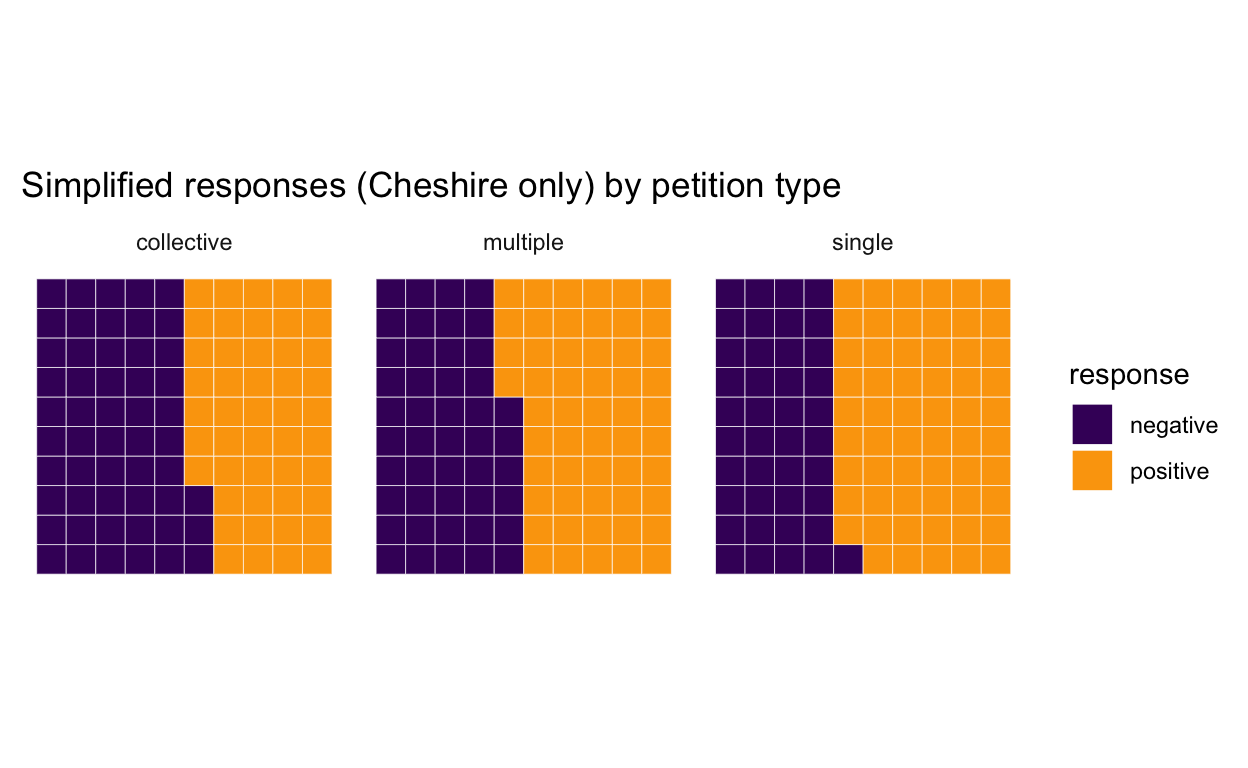
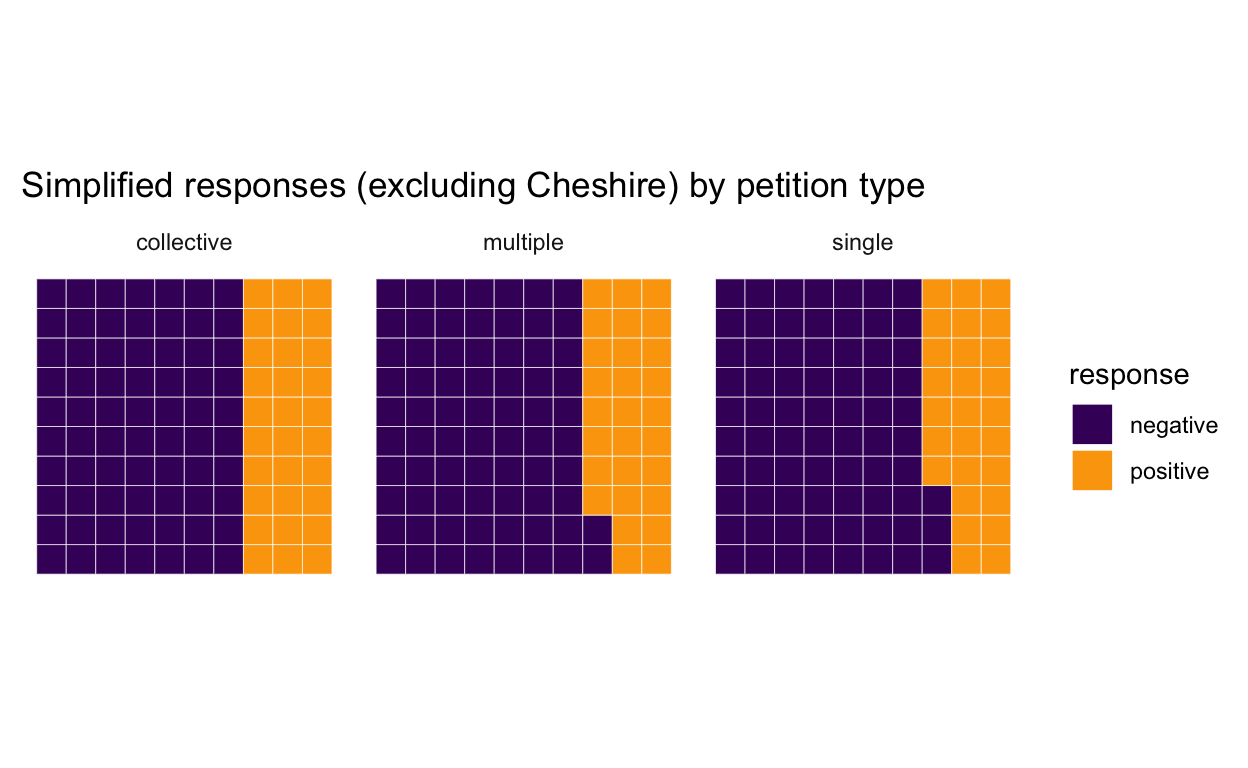
The responses breakdown does show more variation. The single category is far less likely to get no response at all, and is most likely to have requests granted in full. (But, interestingly, collective petitions are most likely to have a reason given for rejection.)
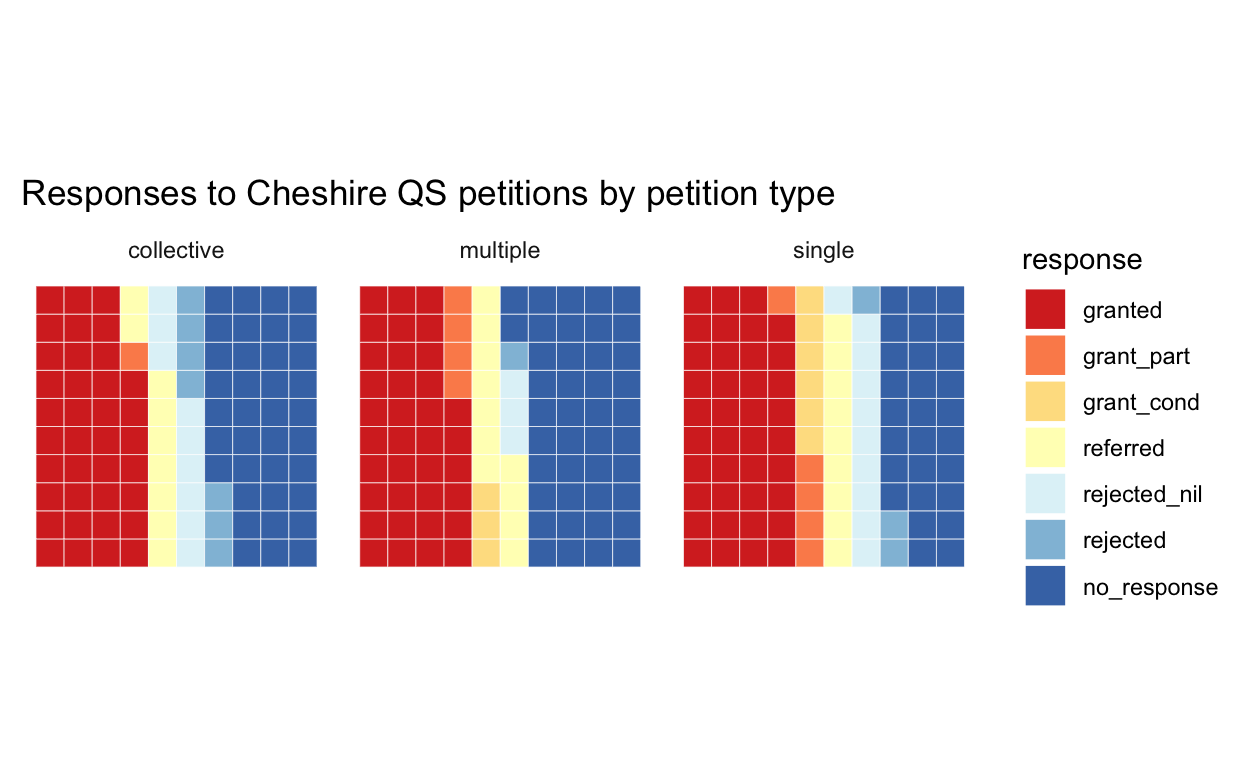
Same breakdown for the other counties.
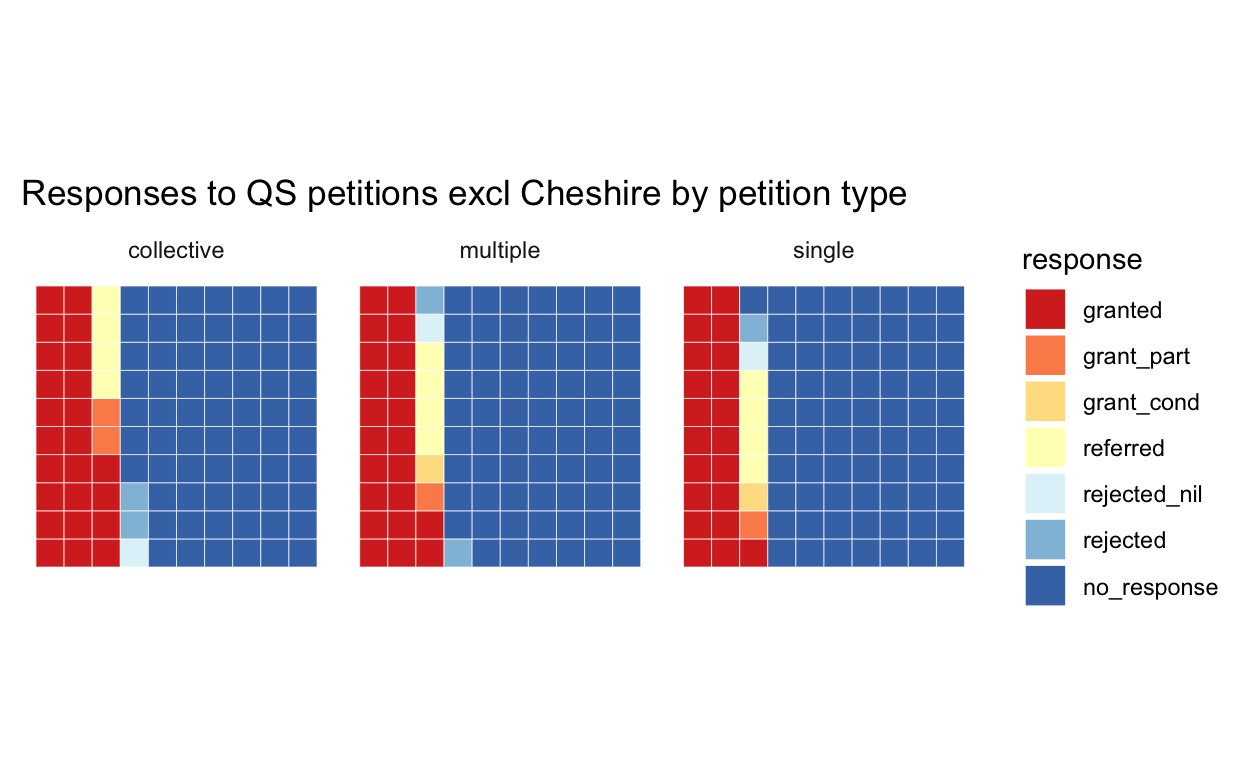
petition gender type
(Collective petitions excluded.)
A summary of gender of all petitioners (but not additional subscribers) per petition:
- f = female only (128 petitions)
- m = male only (343)
- fm = mixed gender (26)
Again there is very little variation in positive response rates. I might have expected slightly more variation in this category as I know there are gendered variations in petition topics; I’ll need to explore this further.
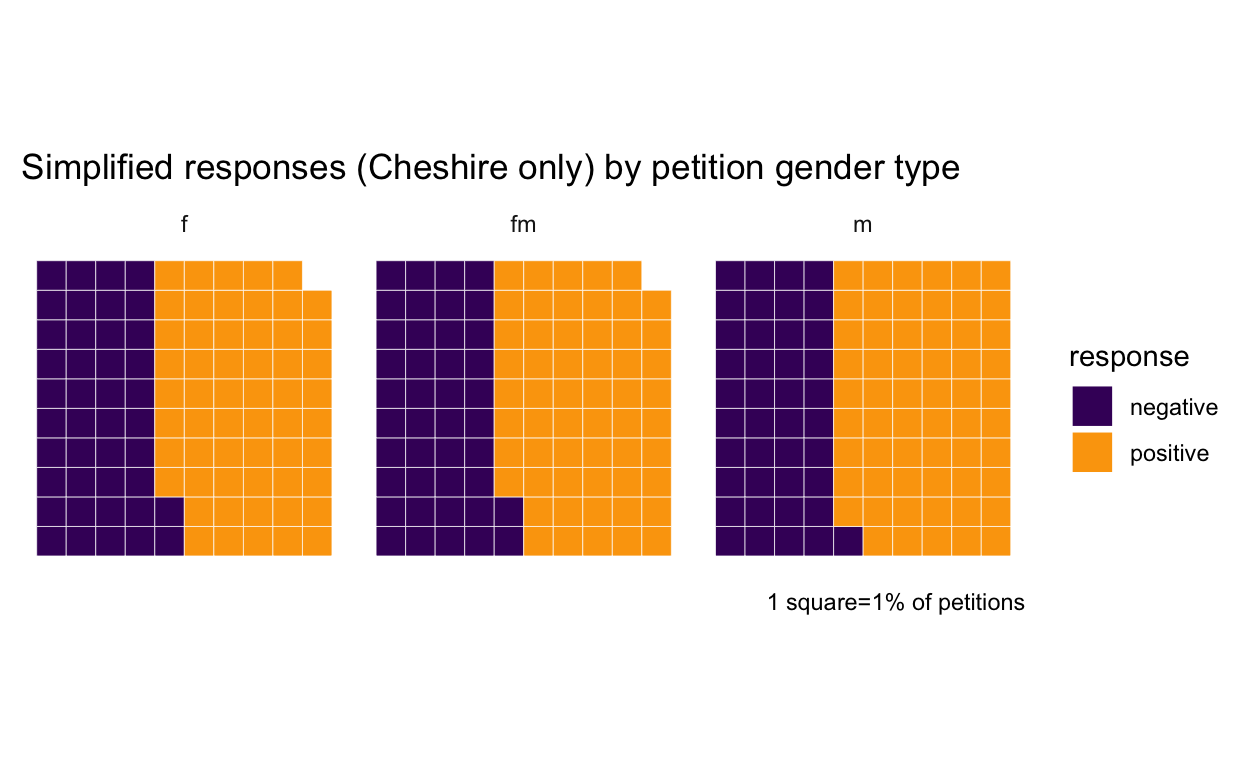
And again, the more detailed breakdown of responses shows up more subtle variations. It appears that petitions involving female petitioners were less likely to have requests granted in full and more likely to have their cases referred to JPs for further investigation.
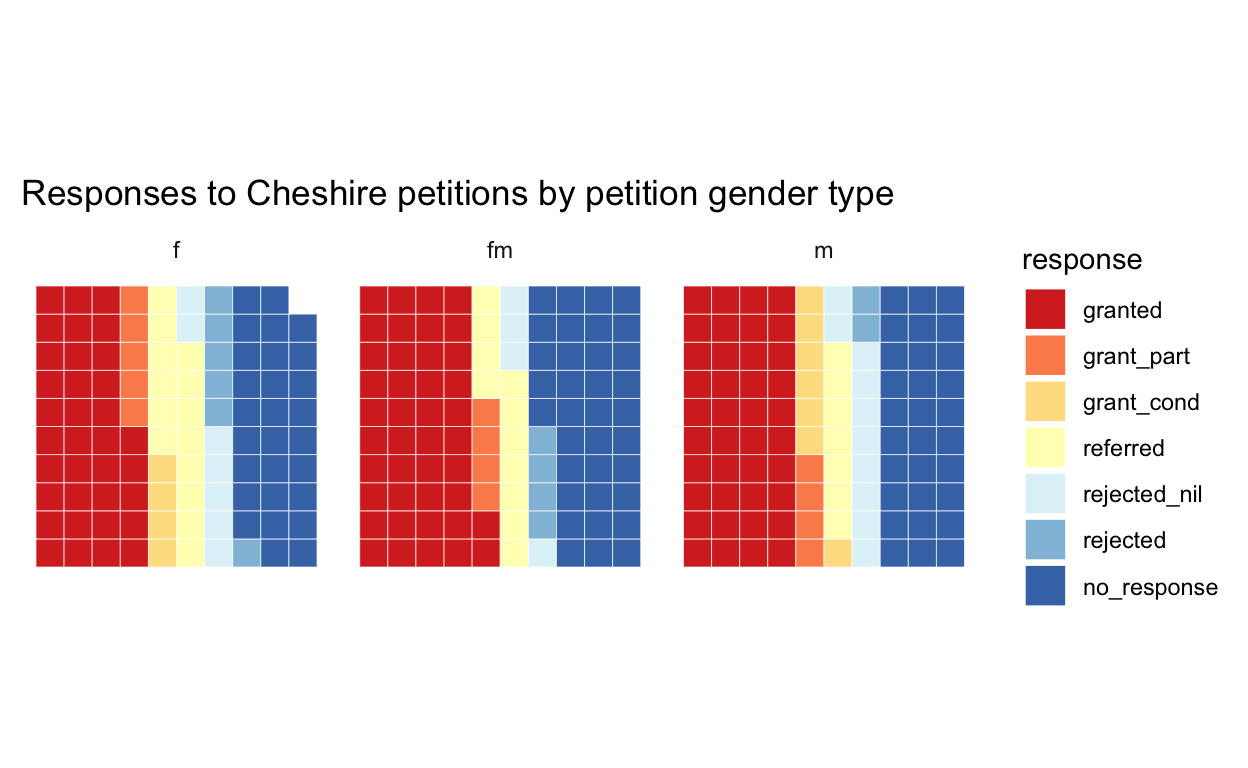
Other counties for comparison.
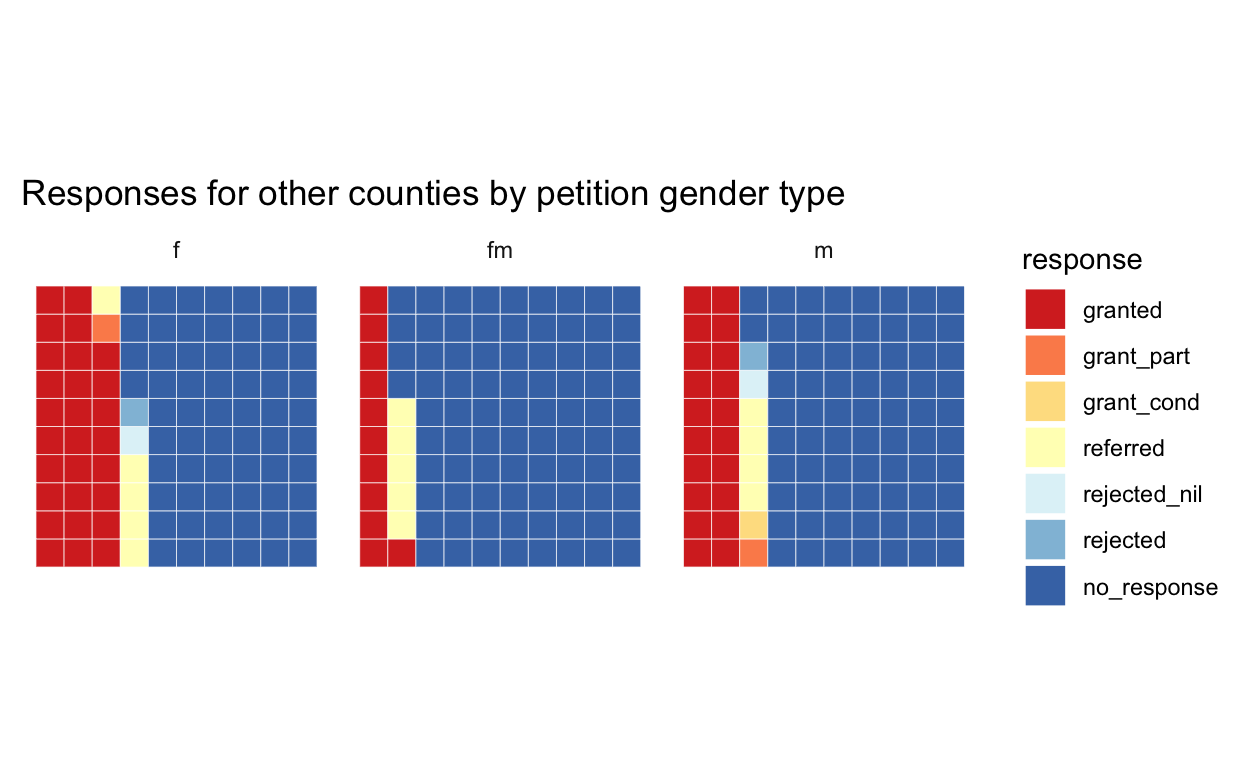
[Updated] Breakdown by topic as well as gender (excluding mixed gender).
For Cheshire:
- Greater tendency for female petitions to be referred is clear across multiple topic categories. (The only topics with a higher % of male referrals are ones that have very very few female petitions.)
- The situation with fully granted requests is a bit more mixed, but most of the lower female % is probably accounted for by the two large (and very distinct!) categories of litigation and poor relief.
